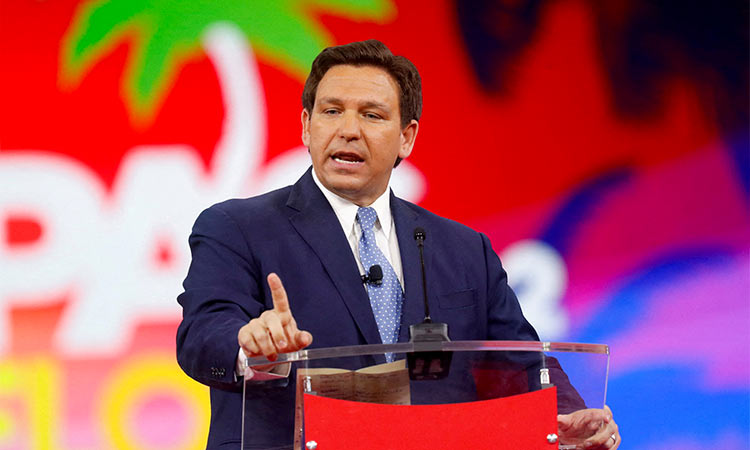Ron DeSantis and the whitewashing of slavery’s horrors

Ron DeSantis greets guest after speaking at US Rep. Zach Nunn’s (right), ‘Operation Top Nunn: Salute to Our Troops’ fundraiser in Ankeny, Iowa. Tribune News Service
Michael Hiltzik, Tribune News Service
With the news in recent days so irremediably grim — what with the mainstreaming of antisemitic drivel by Robert F. Kennedy Jr. and the record heat wave traceable to global warming — I found myself looking desperately for a comic interlude to lift my mood.
That brought me inevitably to the Ron DeSantis clown show. He offers dark comedy, to be sure, but comedy nonetheless. Over the last week, it has featured a ham-fisted attempt to whitewash the horrors of slavery in America. That slavery thing is actually divided into two scenes. We’ll take them in order. Scene One is last Wednesday’s approval by the Florida Board of Education of new standards for the teaching of African American history in the state’s K-12 schools. What caught the attention of educators and other close readers was a provision that the curriculum cover “how slaves developed skills which, in some instances, could be applied for their personal benefit.” Critics have concluded, absolutely correctly, that this provision serves to elide the manifold horrors of slavery by searching out its good side.
Its defenders say that’s just one item in a 216-page curriculum, so what’s the problem? Why, writes Charles C. W. Cooke of the right-wing National Review, the whole package “contains the word ‘slave’ 96 times, ‘slaves’ 23 times, and ‘slavery’ 45 times! The “skills” part, he writes, is only a “tiny (and correct)” piece of the total. Leaving aside the stupidity of parsing a text by counting words, this evades the question of what the point is of placing this item into the curriculum at all. What’s the goal of teaching students that slaves may have learned skills that might have sustained them if they were lucky enough to be freed or escape? Is it to show that subjecting human beings to rape, torture, family disruption, starvation unto death, and other brutality is only one aspect of a practice that also has, hey, its good points? That’s a bit like saying that Jewish men, women and children may have been marched into the gas chambers at Auschwitz, but at least they got a train trip to the countryside out of it.
In its totality, the Florida curriculum aims to minimise the true character of American slavery. Josh Marshall, who holds a doctorate in American history from Brown University but is best known as the founder and boss of the invaluable progressive website Talkingpointsmemo, put his finger succinctly on the curriculum’s thrust in a Twitter thread this weekend. In its totality, he wrote, the text “certainly seems geared to deemphasise the backbreaking agricultural labor which was the lot of the vast majority of slaves during the 200 plus years of slavery.” The curriculum spends an inordinate amount of time on “other places where slavery was arguably worse” than the American South, such as Africa and the Caribbean,” Marshall writes. “The upshot... is definitely to soften the image of North American slavery.” The curriculum makes an effort to underscore the achievements of Black Americans in the modern era and civil rights leaders — though most of those it mentions in the latter context are white (presidents Eisenhower, Nixon and Lyndon Johnson, for example). Two Black intellectuals inexplicably included in that group are political scientist Shelby Steele and economist Thomas Sowell, who are widely regarded by their colleagues as hacks.
The real comic element of this whole affair comes in Scene Two: the formal defense. This was provided by two members of the all-Black task force appointed by the state Department of Education to craft the curriculum. Neither is a historian. They’re William Allen and Frances Presley Rice.
Allen is a retired professor of computer science at Florida Institute of Technology. Rice is a former Army lieutenant colonel and founder and chair of the National Black Republican Assn. Some years ago, Rice wrote a screed about the supposedly secret racist past of the Democratic Party, which she said had “hijacked the civil rights record of the Republican Party and taken blacks down the path of Socialism.” Sure, Democrats were known for part of their history as pro-slavery, and Republicans freed the slaves, thanks to Abraham Lincoln. But no one with functioning critical faculties thinks of either party as holding to those positions today — just the opposite. In a statement tweeted out Thursday by Alex Lanfranconi, a publicity flak for the state Department of Education, Allen and Rice asserted that the intent of the “skills” provision is “to show that some slaves developed highly specialised trades from which they benefitted.” They wrote: “This is factual and well documented.” Is that so? Let’s take a look. Allen and Rice provided us with 16 examples, listed by name and trade, to prove their point.
As it happens, nine of the 16 people mentioned never were slaves. Seven are identified by the wrong trade. Thirteen, possibly fourteen, did not learn their skills while enslaved. One, Betty Washington Lewis, whom Allen and Rice identified as a “shoemaker,” was white: She was George Washington’s younger sister.
A few other examples: Allen and Rice mention Booker T. Washington in the category “teachers.” Washington was 9 years old and illiterate when slavery was banned by the 13th Amendment in 1865. All the skills that brought him to the point of becoming the revered leader of the Tuskegee Institute he acquired as a free man.
Among the four individuals named as having learned blacksmithing as slaves, Ned Cobb was never enslaved, having been born in 1885, and was a tenant farmer; Henry Blair was an inventor born a free man in Maryland; Lewis Latimer was an inventor born free, to escaped slaves, in Massachusetts; and John Henry was a figure of folklore who may never have existed at all.
Of “fishing and shipping industry workers” named by Allen and Rice, John Chavis was born a free Black man in North Carolina who is known as an educator and minister; numerous biographies carry no mention that he was ever employed in fishing or shipping. William Whipper was born in Pennsylvania to a Black slave and her white owner; he inherited his white father’s lumber business and became a noted entrepreneur who helped finance the Underground Railroad. He did at some point own a Lake Erie steamship, which may have confused those indolent researchers Allen and Rice.
Then there’s Crispus Attucks, who is best known as a victim in the Boston Massacre of 1770 and is often portrayed as the first martyr of the American Revolution. He was born into slavery in Massachusetts but learned his trade as a sailor on a whaling ship after escaping, not as a slave.







